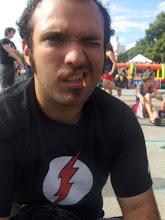
The subject matter is dark and unsettling (and depending on your attitude, pretty funny) but the imagery and themes present in this film by David Cronenberg are driven home by film techniques that are utilized throughout.
The plot revolves around a TV executive named Max Renn played by James Woods who discovers a new type of programming for his network that has just the edge he had been looking for, snuff television. Picked up from a Malaysian broadcast, the program known as Videodrome depicts anonymous victims being tortured and murdered on camera and Renn is tasked with broadcasting this program on his station. Hilarity ensues.
The mood of this film is carried primarily by stylistic lighting effects. In the majority of scenes there is a strong frontal light that mimics that of a television set in a dark room. In these scenes the central characters immersion in the depraved television show is emphasized and we are forced to focus on the characters descent into a state of near madness. These scenes tend to completely mask any traditional sort of lighting, leading one to believe that none of it is used at all.
In other scenes the lighting takes on a typical TV set style of lighting. A great deal of fill and key lighting, with the room almost completely flooded with light. These scenes act as a stark contrast to the ones that involve Renn's degradation and remind us of the split in reality that is occuring for the main character. Additionally, this lighting style reminds us of the medium that is being criticized and commented upon in this film.
The plot revolves around a TV executive named Max Renn played by James Woods who discovers a new type of programming for his network that has just the edge he had been looking for, snuff television. Picked up from a Malaysian broadcast, the program known as Videodrome depicts anonymous victims being tortured and murdered on camera and Renn is tasked with broadcasting this program on his station. Hilarity ensues.
The mood of this film is carried primarily by stylistic lighting effects. In the majority of scenes there is a strong frontal light that mimics that of a television set in a dark room. In these scenes the central characters immersion in the depraved television show is emphasized and we are forced to focus on the characters descent into a state of near madness. These scenes tend to completely mask any traditional sort of lighting, leading one to believe that none of it is used at all.
In other scenes the lighting takes on a typical TV set style of lighting. A great deal of fill and key lighting, with the room almost completely flooded with light. These scenes act as a stark contrast to the ones that involve Renn's degradation and remind us of the split in reality that is occuring for the main character. Additionally, this lighting style reminds us of the medium that is being criticized and commented upon in this film.

No comments:
Post a Comment